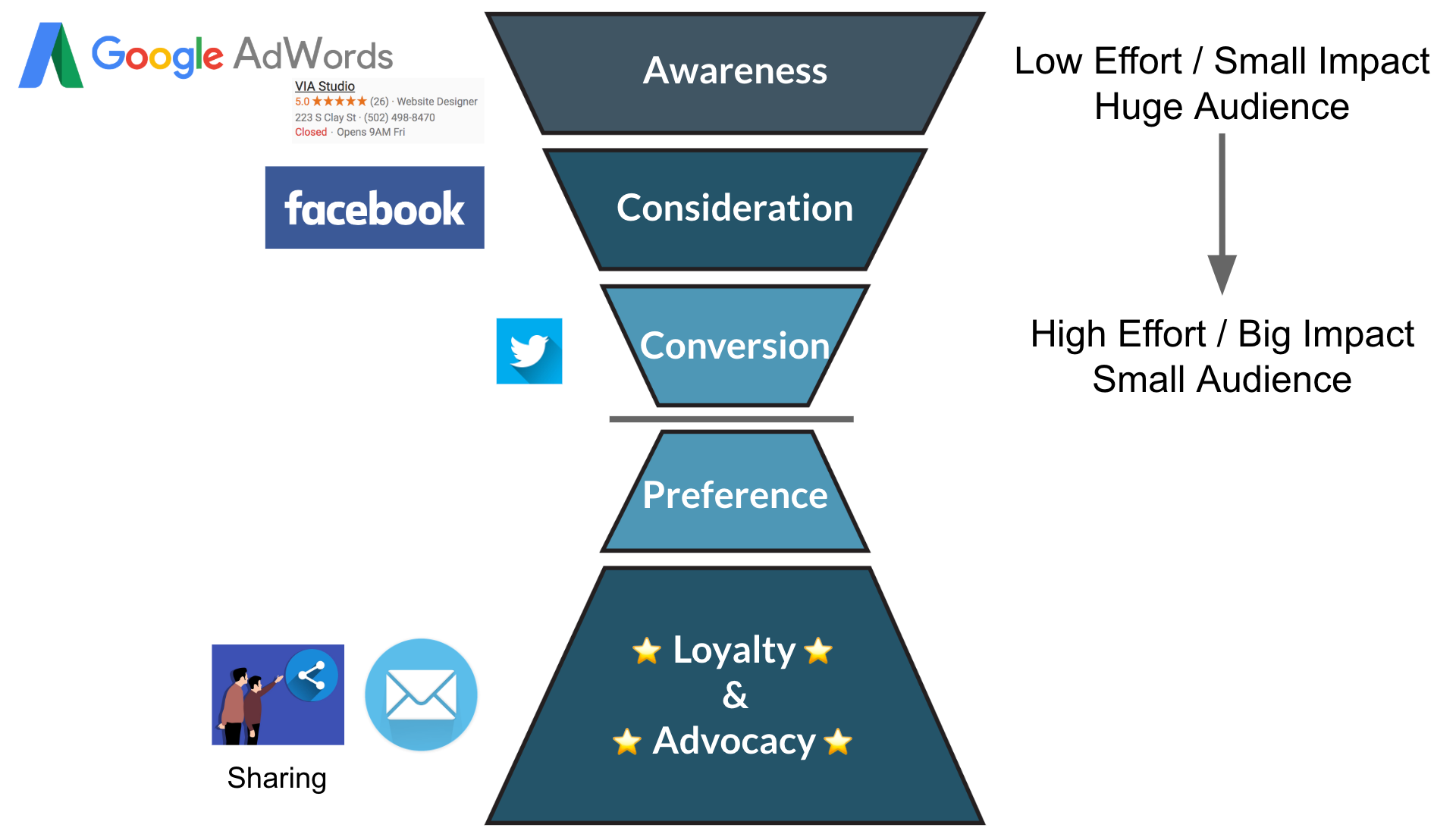When to use Google Search Ads (Adwords) vs Facebook and Instagram Ads?
It’s a question that most of our clients have, when they have a budget for digital advertising:
That’s a simple question that demands a detailed answer. But, here are the basics:
- Find where your audience is
- Figure out where they are in “the funnel”
- Assign your budgets appropriately
Choosing Where to Market: Be Where Your Audiences Are
First, you need to define your audience. That’s a really big, detailed question – so for the sake of answering our #1 question (when to use Google vs Facebook) – we’ll focus on “the average consumer” in the United States.
There is no truly average consumer, but when viewed in bulk, we know the majority of the audiences that an agency like ours, who deals in equal parts consumer and business-to-business brands, are equal parts male and female, and fall between the ages of 24-65.
Another defining characteristic of “the average consumer” is that they use both Google and Facebook or Instagram on the regular – nearly all Americans use one or the other daily – and here are the numbers that back that up:
- According to Hootsuite, 68% of Americans use Facebook daily, 35% use Instagram daily[1]
- 68% of Americans do a search in a month, and the average searcher searches Google 3-4 times a day (at least as of 2016) [2].
So that is why we are focused on Google vs Facebook today. There are plenty of other platforms – such as Twitter, Pinterest, Snapchat and YouTube that all offer ad platforms but they also tend to break differently among demographic lines – age, gender, etc. However – that is a far more expansive and detailed conversation (and frankly, why “strategy” exists!).
So let’s move on…
Let’s Talk About “The Funnel”
Last year, we held a day-long workshop for the Center for Non-Profit Excellence – talking with an amazing group of leaders and marketers for non-profit groups. Their questions surrounding digital advertising spurred the article you are reading, and I put together a quick illustration to help guide the conversation.
If you are reading this, you probably have some sort of familiarity with the “marketing funnel” – but if not, it’s a fairly straightforward idea. The funnel is a visual representation of a consumer’s journey with your organization. We’re attempting to get consumers down our funnel, and at the bottom is whatever makes them a customer of ours – probably a product sale but could also be a membership, donation or a sales lead.

Each level of the funnel directly corresponds to a different user situation. At the AWARENESS stage, customers are just finding out about your product or service. We draw them in with content and info. Being where the consumer is searching is key during the AWARENESS phase. CONSIDERATION is next – consumers are looking at numerous options, comparing and contrasting, as well as considering if what you are offering has the right value to them. All of a sudden, the conversions has become far more individualized and personal during CONSIDERATION. After considering your offerings, the next (and hardest) step is CONVERSION. Intensely personal, this step is where the deal is sealed. The consumer’s trust that they are making the right decision must be high.
What to do with the funnel?
The funnel is a map – and you have to think about how many of your audience are in what step of the funnel. If you are a new brand, product or service – most of your audience will be in the Awareness step. If you are an established brand, most of them will be in the consideration step – but you can’t ignore that pipeline of new consumers in awareness.
Our observation is also that at the top of the funnel, there is a HUGE audience, but your impact is going to be small – value-wise. Nearer the conversion point, the audience gets smaller, but each “touch” you have with the consumer has more and more value. That balance between size of audience and value of impact are critical concepts when it comes to assigning budget.
The Strengths and Weakness of Google vs Facebook
Google is for finding things out and Facebook is for … well we aren’t sure but you look at it a million times a day and it knows a LOT about you.
I’m going to generalize here to give an example of the thought process: let’s assume that you are an established product or service, but just haven’t spent a lot of time or effort marketing. People know you and have visited your website (you do have a website, right?).
Google Search works by you “bidding” on keywords that directly or indirectly match the search terms of the consumer. Facebook works by serving ads targeted (demographically, geographically, by “affinity” or by their engagement with your page or website) to the consumer – who has given up some of that info in exchange for access to Facebook.
Both are valid approaches – but both fit into different levels of the funnel.
Google Search tends to favor the “awareness” level of the funnel – broad awareness as we can easily bid on keywords that are similar to our product (e.g. “running shoes”), and when the consumer types in “best shoes for running”, our ad is likely to appear. In this way, we have access to a lot of potential consumers who have shown an intent towards our product.
Facebook tends to favor those further down the funnel – in “consideration”, but only because they aren’t there to search. Remarketing (targeting consumers that have previously visited your website) is one of the most powerful tools Facebook offers. Since we know they’ve shown an intent toward our product, we can offer them more information to help them seal the deal (in the form of an ad or a post). That’s not to say that people don’t use Facebook intentionally to research – they do – but not quite as intentionally as Google Search. Few people type in “running shoes” into Facebook and click on what pops up. However, they might see an ad for “New Balance” elsewhere, and then search for “New Balance” and land on their Facebook page.
Intentional vs Unintentional and Frequency of Use
Now, let’s shift perspective to that of the consumer. When consumers use Google Search, they are most often intentionally looking for answers. When consumers use Facebook or Instagram, they are most often not – they are looking for updates from friends – and you could generally argue that scrolling through a feed is unintentional.
Another factor is frequency of use. Generally speaking most people will spend FAR more time in Facebook or Instagram than in Google Search – but as we just mentioned, the time spent on Google Search is far more focused and intentional. However, users may skip a day or more between intentional searches. People will go back to Facebook multiple times a day.
Now that we understand that a bit better – we can understand when we should use Google Search Ads and when we should use Facebook and Instagram.
In short:
- We tend to use Google Search for acquiring new potential customers by keying off of intentional searches related to our product.
- We tend to use Facebook because the frequency of use is HIGH and the ability to directly target consumers that have engaged with us previously is so easy.
Budgeting
How much should you spend, then? Well, generally any amount, no matter how small – is going to get you invaluable data. We tend to start small and then recommend bigger budgets as we see results and can make decisions about targeting, and see tangible results.
Google Search Ad costs vary on the search traffic (it’s a bidding market, remember!) of the keywords you desire. Facebook is strictly cost-per-click, assuming your targeting is not so narrow you have no audience to show your ads to.
Generally most of our marketing plans for similar situations end up like this:
- Google Search Ads: 60%
- Facebook / Instagram: 40%
There’s a lot of variables in that math, so the above is a ballpark. However, Google tends to cost a little more BUT is also a major driver of building audience awareness. I can’t say one is more important than the other – but to begin building a thriving marketing audience, Google Search is critical.
The Next Level: Remarketing and Audience Building
Both Google and Facebook allow you to “tag” your website and build audiences of recent visitors – and this is hands-down the most effective way to spend your ad dollars. Facebook also allows for the uploading of prior customers / subscribers and the creation of demographically similar “Lookalike” audiences.
Once those remarketing audiences are in place, you can start to shift more of your budget to discretely targeted audiences inside of Facebook or Instagram, and ratchet down your Google Search Ads spend.
Getting it “Right”
As I mentioned at the top of the article, we’ve made some pretty broad assumptions based upon data and generalities – and that can help you start a digital marketing plan. But as you get closer to the conversion point for a consumer, your job becomes harder and harder – and you must be more nuanced and understanding of them for them to feel comfortable with you. And that … is where detailed digital marketing strategy pays off.
So, for now – spend a little $$ to get started with both Google Ads and Facebook, and learn, iterate and analyze. And if you don’t have the time, patience or interest in doing so – we’ll be glad to help! Just drop us a line.
1 – 41 Facebook Stats That Matter to Marketers in 2019 – Hootsuite
2 – The State of Searcher Behavior Revealed Through 23 Remarkable Statistics – Moz
Related Posts
Putting Your Customer Data to Work
By: Nick Wunderlin on 6/20/2023
What are Customer Lists? Just about all major, self-serve ad platforms allow marketers to upload customer lists. These customer lists allow marketers to re-engage with past customers, show ads to newsletter subscribers, or even find new customers similar to their existing ones.
Read More »Apple iOS 14 Privacy, Facebook, VIA and You
By:Ben Wilson on 1/28/2021
Looking at the major impact that Apple's new privacy-focused iOS 14.4 will have on the world of privacy - specifically digital advertising. We'll look at why this is important, why Facebook is scared, and what we at VIA think about it.
Read More »

